Monarch Madness: Summing Up
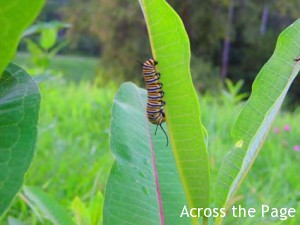 We first started looking for monarch caterpillars in early August. I’ve posted on our experience as it has unfolded, and as the adventure draws to a close I want to sum up and link to the Outdoor Hour Challenge on September 30.
We first started looking for monarch caterpillars in early August. I’ve posted on our experience as it has unfolded, and as the adventure draws to a close I want to sum up and link to the Outdoor Hour Challenge on September 30.
The adventure began with fruitless searching, as I wrote about here. Poking around online, I learned that monarchs produce four generations of butterflies each year, and this encouraged me not to lose hope. Soon after that, we were pleased to find three caterpillars in a nearby park — two more than I was really interested in having, but no big deal.
It was only the beginning. We’ve had varying numbers of caterpillars on the counter since then, first in jars and then, when we reached 15, in a 10-gallon aquarium. I’d become anxious that the Village would mow the milkweed field, and then I stumbled upon this site with its information about both the dwindling monarch population and how to raise them in larger numbers.
So we tried it.
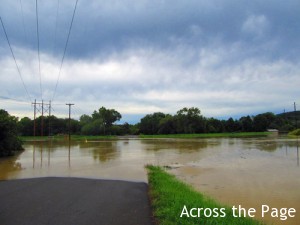 Nobody mowed that park. As it turned out, I’m glad we got carried away, because Tropical Storm Lee dumped so much rain on our upstate New York region that we had a record-breaking flood. Along with all the human and economic costs, the park where we got all the caterpillars was completely covered with water. It felt good that we had saved some of them.
Nobody mowed that park. As it turned out, I’m glad we got carried away, because Tropical Storm Lee dumped so much rain on our upstate New York region that we had a record-breaking flood. Along with all the human and economic costs, the park where we got all the caterpillars was completely covered with water. It felt good that we had saved some of them.
It was fun having the caterpillars; none of us could walk through the kitchen without pausing to observe. We kept track of their size, measuring them each day and noting when they molted. I posted my 10-year-old’s caterpillar journal here. (It features some clay art work, written observations, and sketches with some of my photos interspersed.) I’ll admit that supplying them with milkweed and cleaning the aquarium each day got old, and I was glad when they were all safely in their chrysalises. Here’s a repost of the video I took of a chrysalis formation, a process we’ve gotten to see a number of times without losing the wonder of it:
Then after a bit, we got to see them all emerge. The first two hatched last week, and a steady stream of them has been emerging this week. Here’s a video of a butterfly coming out of the chrysalis.
It’s always amazing to me to see how those potato-chip-like wings expand and flatten, and those huge abdomens slim down, in such a short time.
We’ve released them by setting them on a geranium I have in a pot out front. I don’t think monarchs are especially fond of geraniums, but it happens to be what I have. Next year I’m going to plant a butterfly garden, but this year the geranium has been logging many hours as a roost and launch pad.
My daughter is our resident butterfly whisperer, getting them to step onto her finger and placing them on the plant. One flew up into my hair once, but it apparently seemed no more promising than the geranium, and the butterfly moved on.
At first I was a hovering, overprotective butterfly shepherd. (?) Often they sit/hang for quite a long time on the plant — sometimes even overnight — before they take off. We always wait for two or three hours before putting them out there, and I have the plant in a sheltered spot where they won’t get wet if it rains. But I’ve gotten used to their slow acclimatization.
Most of the butterflies emerge in the late morning or early afternoon, but one — we named him Tardy Timothy — waited till around 6:30 at night. I figured he’d overnight inside, but by 10:00 he was pacing and flapping around on the top of the aquarium. I transferred him to the geranium and he hung out there till the following afternoon.
Only two chrysalises remain, and it will be another day or two before they hatch. The whole experience has been fun. I remember going through it as a child with a caterpillar, but this has been much more involved. Getting to observe the chrysalis formation, measuring their growth, noting their molts, and seeing them emerge has been really wonderful. We’ve learned to tell males from females, gleaned quite a bit of information about monarch migration, and accumulated some new vocabulary. Best of all, we’ve acquired a new sense of wonder and appreciation for this one tiny piece of the intricate, incredible creation we inhabit. It may sound silly, but it’s impossible to see one of these winged beauties floating by without some sense of awe. And this is just one species of insect!
Up till this year, I’ve used packaged science curriculum (Real Science-4-Kids and encyclopedias), and I really have no complaints about it. But the depth and extent of learning taking place as we simply tune into the world around us — much of it self-motivated — exceeds immeasurably what we’ve accomplished in science before. Add to that the personal investment of caring for an aspect of creation, and an ecological ethic begins to develop. I couldn’t be more pleased with how it’s going.
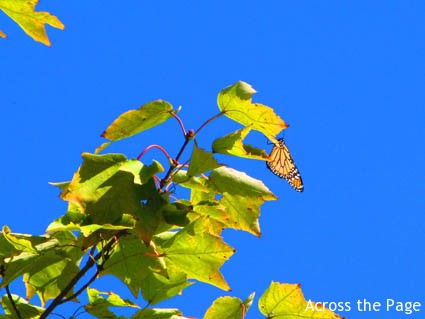
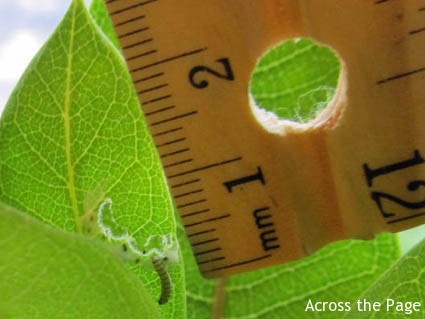
For a roundup of my previous posts on our monarch adventures, feel free to browse the monarch butterflies entries. To view the other posts in the Outdoor Hour Challenge, click the button below on September 30.

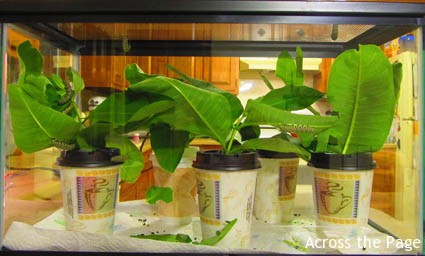
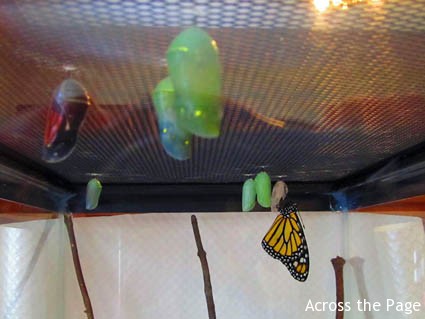
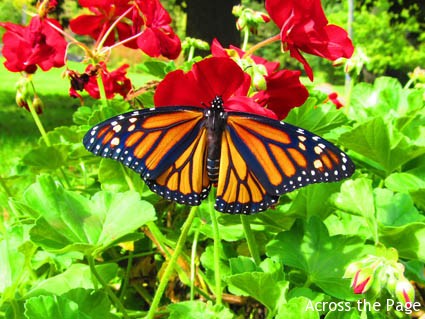
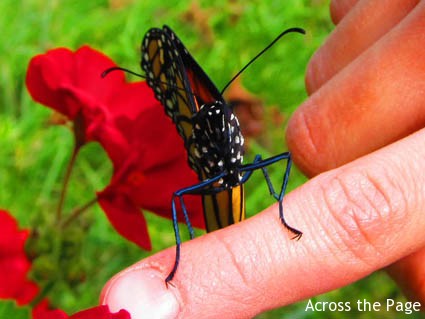
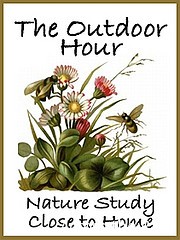
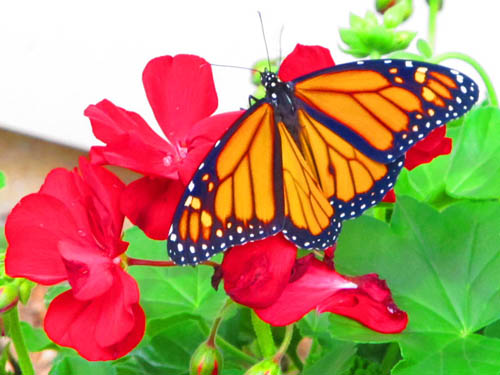
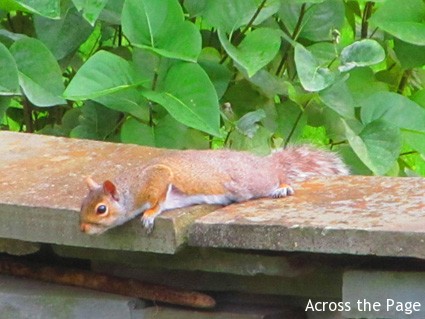

10 Comments
Barb-Harmony Art Mom
Wow! This is such a thorough and delightful study of your local monarchs (and milkweed too). I really enjoyed reading your experiences and seeing your gorgeous images.
Thank you so much for sharing your link with the OHC.
Barbara H.
I enjoyed watching the butterfly emerge from the chrysalis! Enjoyed the whole journey, really. I share your awe over these creatures. Whenever a butterfly flits by outside the window, I want to stop and watch for a moment.
DebD
I’ve only been following this series a bit, but it was nice to ready your summing up of the experience.
Ruth
How great! You and your kids learned so much from this!
GretchenJoanna
Thanks so much for sharing your project quite thoroughly. It’s amazing to me how the chrysalis forms, even athletically at the end, without becoming detached from the leaf.
Barbara
A kindred spirit! Monarchs are wonderful and so are all your entries about them. We have not tried raising them indoors, but I think we might need to do that next year as well! Thank you for the inspiration:)
Kim
AWESOME!!!! I love butterflies! I just spotted a monarch laying eggs on our milkweed a few days ago. We’ve brought caterpillars inside the past couple of years, and it is so amazing to watch the whole process. How neat that you rescued so many! Off to read your daughter’s journal.
Janet
Wow, you must live south of us. I’d love to see one laying eggs!
Barbara, your post inspired me too. We’re going to find out more about tagging for next year. :-)
Zonnah
I had no idea the chrysalises formation went so fast! Thank you so much for the videos :)
Ellen
This is wonderful! Especially since it’s from the natural surroundings. Last time we ‘grew’ monarchs, we bought them from a mail-away company when my children were little. I think we’ll have to try again next spring. My kids would still like to see the metamorphosis.